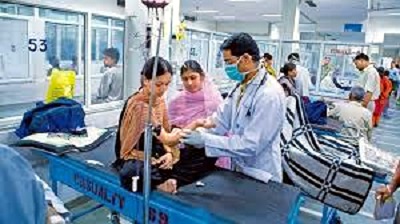Context-
In the last week of May, a fire in a private neonatal care nursing home in New Delhi resulted in a tragic loss, sparking intense media coverage and political blame games. Incorrect reports claimed that numerous nursing homes in Delhi operate without a license. Despite the initial uproar, the incident was quickly forgotten, leaving grieving parents and a glaring spotlight on the systemic failure of healthcare regulations.
Status of Health-Care Regulations
- Excessive and Unrealistic Standards : Health regulations are a critical aspect of any health-care system. However, in India, the challenge is not the lack of regulations but an excess of them. Some states have over 50 approvals under multiple regulations that each health-care facility must comply with. Despite this, there is a prevailing belief among officials and others that the private health sector is under-regulated. Furthermore, many regulations set unrealistic standards. For instance, the Clinical Establishments (Registration and Regulation) Act, 2010, has not been widely adopted due to its impractical provisions. Similarly, the Indian Public Health Standards (IPHS) have only been met by 15% to 18% of government primary health-care facilities in India, despite being revised twice since their introduction in 2007.
- Mixed Health-Care System : India's health-care system is a mix of public and private sectors, with the private sector delivering nearly 70% of outpatient services and 50% of hospital-based services. In states like Maharashtra and Kerala, better health indicators are attributed to the effective functioning of private health-care facilities. However, there is a misconception that government health sectors always adhere to regulations better than the private sector. This perception was challenged by two incidents in 2017 where both a government hospital and a private hospital in Delhi declared newborns dead when they were alive. The private hospital faced a temporary suspension of its license, while the government hospital only faced an inquiry committee, highlighting the uneven enforcement of regulations.
Challenges in the Regulatory Framework
- Delays and Bureaucracy : One major issue faced by private nursing homes and clinics is the delay in obtaining approvals. Despite applying for renewals well in advance, approvals can be delayed for months, creating a significant burden on facility owners. This sluggish approval process hampers the efficient functioning of health-care facilities and needs urgent attention.
- Heterogeneity in the Private Sector : The private health sector in India is diverse, ranging from single-doctor clinics and small nursing homes to large corporate hospitals. Smaller facilities, which often cater to middle and low-income populations, play a crucial role in delivering affordable health services. However, these facilities are often expected to meet the same standards as large hospitals, making compliance expensive and potentially transferring costs to patients.
|
Other issues associated with India’s Healthcare Sector
|
Proposals for Improved Healthcare Regulations
- Simplified and Practicable Guidelines : To address the current challenges, health-care regulations should be formulated with practical and implementable guidelines. This involves harmonizing multiple health regulations and simplifying the application process. Approvals should be granted in a time-bound manner to avoid unnecessary delays.
- Differential Approach for Different Facilities : Recognizing the diverse nature of health-care facilities, regulations should adopt a differential approach. Smaller clinics and nursing homes should have different standards compared to large hospitals. Essential and desirable points for each category should be overseen by regular self-assessment and regulatory visits. The government should consider subsidies and funding to help smaller facilities adhere to these standards.
- Involvement of Key Stakeholders : The process of formulating regulations should involve representatives from doctors' associations, facility types, and community members. This collaborative approach ensures that regulations are practical and meet the needs of all stakeholders.
- Promoting Single Doctor Clinics and Smaller Facilities : Single-doctor clinics and smaller health-care facilities are crucial in delivering primary care and keeping health-care costs low. These facilities need support rather than being burdened with excessive regulations. Promoting these facilities aligns with the goal of the National Health Policy, 2017, to deliver people-centric, accessible, affordable, and quality health services.
- Sustainable Health Governance : This could include implementing better management systems, strengthening healthcare regulatory bodies and creating independent oversight mechanisms to ensure more effective and efficient healthcare services. Also, suitable cybersecurity measures should also be taken to secure critical medical infrastructure and data from any cyber attack like recent Ransomware Attack on AIIMS Delhi.
- Addressing the Root Causes : The fire tragedy in Delhi should prompt a thorough assessment and concrete planning to address the root causes of such incidents. Simplified and implementable regulations, developed in collaboration with key stakeholders, are essential. Fair implementation, time-bound decisions, and promoting smaller health-care facilities with subsidies are necessary steps to enhance quality and safety.
Conclusion
India's health-care system requires a nuanced and calibrated approach to health regulations. Simplifying the regulatory framework, adopting a differential approach for various types of facilities, involving key stakeholders in the formulation process, and promoting smaller health-care providers are essential steps. By addressing these issues, India can move towards achieving the goals of the National Health Policy, 2017, and ensure a health-care system that is accessible, affordable, and of high quality.
|
Probable Questions for UPSC Mains Exam- Question 1: Discuss the challenges faced by India's health-care system in terms of regulatory policies and the implementation of health standards. What steps can be taken to create more effective and practical health regulations? (10 Marks, 150 words) Question 2: Analyze the role of the private health sector in India's mixed health-care system. How can regulatory frameworks be adapted to support smaller health-care facilities such as single-doctor clinics and nursing homes while ensuring quality and safety? (15 Marks, 250 words) |
Source- The Hindu







